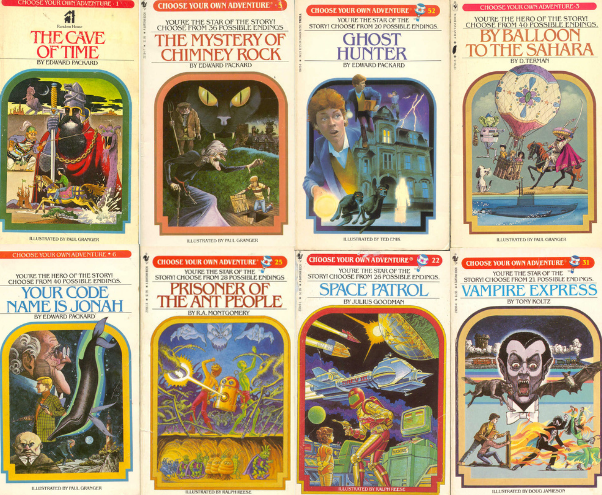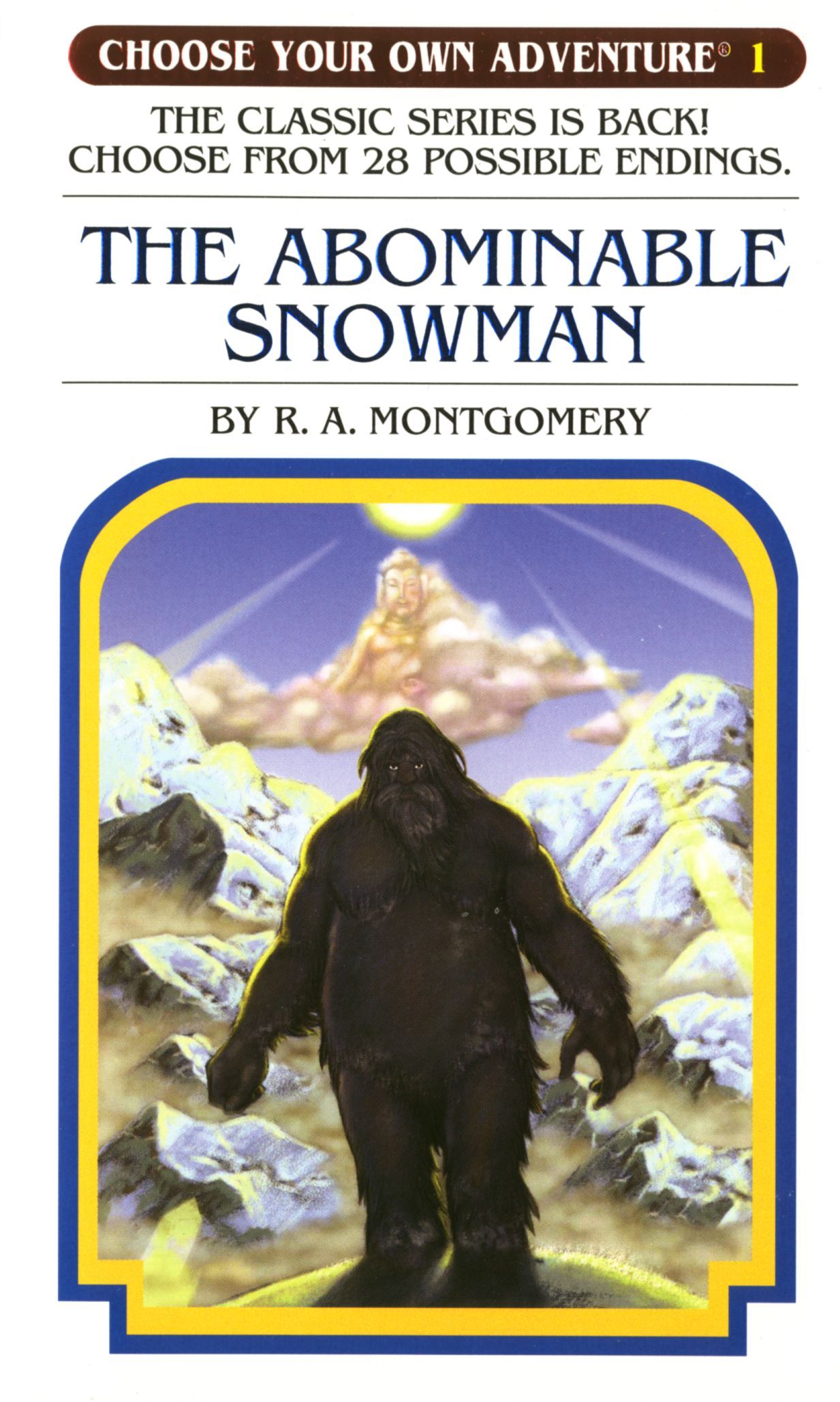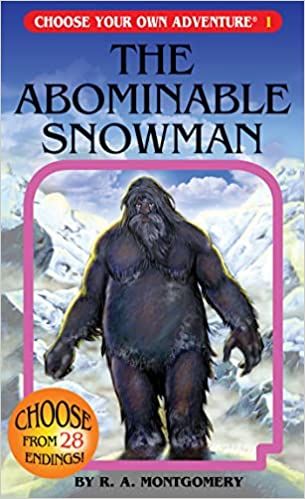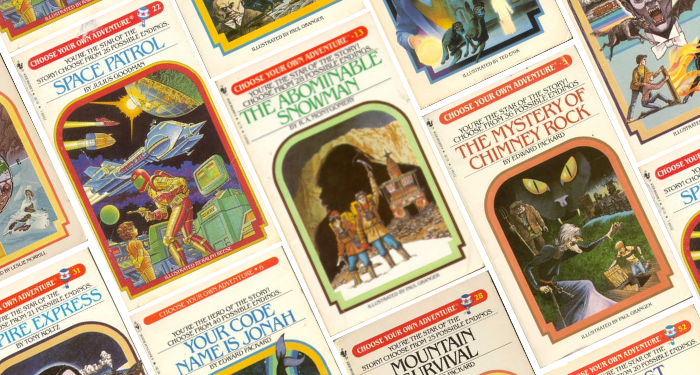I can still picture it: my mom taking my brother and me to the library on a Saturday morning to pick out that week’s book stacks. I had just moved from the downstairs children’s section to the second floor, where the YA books were. And my very favorite place to look for new books were those rickety, mass-market spinner racks that caused covers to curl and pages to get stuck. I loved finding new mysteries and ghost stories, but most of all, I picked up every single Choose Your Own Adventure book.
There was something about these pulpy, compact books that other books didn’t have. It was the feeling that I was in the story. It was the sense that I could read it over and over again and try to work out every possible ending. It was the vague Scooby Doo-like feel of trying to catch sea monsters or outwit a villain in a haunted house. I loved every bit of it, and so did millions of readers, propelling it into the booming and unmatched brand it is today.
Initial Conception and Creation
In 1976, R. A. Montgomery was in charge of a small independent press when Ed Packard approached him with a brand-new idea. After telling his children bedtime stories and asking them about the ending and receiving two different answers, he developed the very first multiple-ending book. His manuscript came to be called Sugarcane Island, and he wanted Montgomery to publish it. Packard knew Montgomery had previously worked in the design of role-playing games in the 1970s, and he knew his new manuscript, branded as a role-playing book, would be exactly what Montgomery was looking for. And it was. The first book was released under the brand name “The Adventures of You.” But sales weren’t as good as Packard had hoped for, so he took his second book to publisher Lippincott instead, selling two more, but Lippincott never registered the format or the brand for trademark.
So Montgomery, seeing an opportunity, wrote his own second book in the series, Journey Under the Sea, and still held the rights to The Adventures of You series. In 1978, Bantam was beginning a new children’s imprint, and Montgomery took the series to the publisher, asking if they would like to acquire. He, along with original writer Ed Packard and another writer, Doug Terman, all signed on to write more of these role-playing books that Publishers Weekly at the time called “an original idea” and “well-carried-out.”
A Rise in Popularity
Even after all the selling and trademarking, the Choose Your Own Adventure books did not immediately start off as the blockbuster series they became. Once the series was published by Bantam, the books finally had a large publishing house and all its resources for marketing, and they began advertising it as a revolutionary way of reading and giving away thousands of copies to book fairs, educators, and 100,000 copies were placed in libraries across the country. Between 1979 and 1999, more than 250 million copies of CYOA books were sold.
Kids were collecting the books like trading cards, so the publisher ramped up their schedule, aiming to publish a new CYOA book every month, one of the first to move at this speed, with other series later to follow suit, like the Baby-Sitters Club and Sweet Valley High.

The series also was published right on the heels of the creation and boom of the hugely popular role-playing game Dungeons & Dragons, which made its debut in 1974. As the rise in this gaming format hit more households and more groups of friends, they began to look for more activities that held this same format. CYOA came along at the perfect time, and this was something that could be completed solo, so you didn’t need a large group of friends to participate. In addition, the original D&D excluded many people, including women and LGBTQIA+ people, among many others. And when it wasn’t exclusionary, it was designed to make certain characters weaker and less important. So the nature of the CYOA, which only featured You, the main character, were more appealing to broader groups of people and more inclusive (though not perfect, still featuring books with white characters on the covers and featuring stories of white characters exploring “exotic” and “foreign” lands).
But after the series boom, the rise of video games took over in the late 1990s, and in 1999, Bantam retired the brand as newer interactive storytelling caused decline in sales. But Montgomery wasn’t ready to throw in the towel, and he formed his own new company, Chooseco, in 2006 to restore the series and revitalize them into a brand-new, full-fledged brand.
Choose Your Own Adventure Today
Not only has CYOA rebranded many of its original books and now publishes them in multiple formats, but they also publish CYOA-branded education books, board books for toddlers, adventure chapter books for young readers, the classic stories, and even role-playing board games.
-

The original Abominable Snowman cover -

The new Abominable Snowman cover
The publishing company did experiment with including titles for ereaders, which, in the early days of the Kindle, was difficult. But now with tablets and easily clickable materials, those stories have become easier to experience on electronic devices, though for a reader experience, there is something about being able to mark the three different paths you could take with your finger, just in case you flip to page 83 and accidentally stumble into an ending.
Chooseco isn’t planning on stopping with just books though. Aiming to expand even farther, in 2013, Twentieth Century Fox acquired film rights and has consistently been working to develop execution ideas since. Suggestions for how to keep the interactive element include apps via consumers’ phones or by using the television remote control. The studio recently brought in Love, Simon director Greg Berlanti and hasn’t given up trying to crack how to nail the interactive storytelling in the visual space.
Shaping a Generation of Readers
No matter what kinds of books they read, most readers have picked up at least one of these classics, if not more, and for kids who grew up in the original era of the books’ height of fame, these were a pop culture phenomenon that were hard to miss. From page one, readers knew this was not like any other story, and were immediately confronted with a warning paragraph about the adventure they were getting ready to step into.
And in the age of growing up amid Stephen King and other horror classics, books geared toward kids that gave them the agency to make the decisions they always wanted to make (instead of shouting at another character for going into the woods alone) had an incredible appeal unmatched by other books. Not to mention, the CYOA did have a certain horrific element to them, which other books did not. Nowhere else could you pick up a parent- and teacher-approved book that contained possible shark attacks, alien abductions, haunted mansions, and worldwide escapes from evil treasure hunters after you.
Nostalgia culture is not new, but it’s certainly experiencing a high surge right now. And with the rise of shows like Stranger Things and the remakes of Stephen King film classics and their popularity only growing, it makes sense that the Choose Your Own Adventure brand is one ’80s and ’90s kids can’t stop thinking about and that Gen Z kids are attracted to.
“The interest and passion for the interactive paradigm seems undimmed,” Chooseco Publisher Shannon Gilligan told The Atlantic. “People love being at the center of the story making decisions. Obviously tons of adults who grew up on them are buying them for their own children.”
If the kids in your life aren’t quite ready for CYOA, try these Pick-a-Path Picture Books Like Choose Your Own Adventure. And to continue your very own Choose Your Own Adventure story, turn to page…


Comments (0)